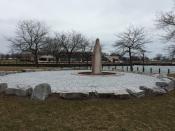 Bitte logge dich ein, um die Koordinaten zu sehen.
Bitte logge dich ein, um die Koordinaten zu sehen.
 2x gefunden
2x gefunden  0x nicht gefunden
0x nicht gefunden  1 Bemerkungen
1 Bemerkungen  0 Beobachter
0 Beobachter  Bewertet als: n/a
Bewertet als: n/a
 Cacheattribute
Cacheattribute






 Beschreibung
EN
Beschreibung
EN
The Great Famine an Gorta Mór, or the Great Hunger was a period of mass starvation, disease, and emigration in Ireland between 1845 and 1852.
It began with a blight of the potato crop that left acre upon acre of Irish farmland covered with black rot. As harvests across Europe failed, the price of food soared. Subsistence-level Irish farmers found their food stores rotting in their cellars, the crops they relied on to pay the rent to their British and Protestant landlords destroyed. Peasants who ate the rotten produce sickened and entire villages were consumed with cholera and typhus. Parish priests desperate to provide for their congregations were forced to forsake buying coffins in order to feed starving families, with the dead going unburied or buried only in the clothes they wore when they died.
Landlords evicted hundreds of thousands of peasants, who then crowded into disease-infested workhouses. Other landlords paid for their tenants to emigrate, sending hundreds of thousands of Irish to America and other English-speaking countries. But even emigration was no panacea -- shipowners often crowded hundreds of desperate Irish onto rickety vessels labeled "coffin ships." In many cases, these ships reached port only after losing a third of their passengers to disease, hunger and other causes. Many Irish criticized Britain's delayed response and further blamed centuries of British political oppression on the underlying causes of the famine.
The Irish Famine of 1846-50 took as many as one million lives from hunger and disease, and changed the social and cultural structure of Ireland in profound ways. The Famine also spurred new waves of immigration, thus shaping the histories of the United States and Britain as well.
The combined forces of famine, disease and emigration depopulated the island; Ireland's population dropped from 8 million before the Famine to 5 million years after.
The Western New York Irish Famine Memorial
Waterfront – La Riviere Street
Designer: Rob Ferguson
Western Irish New York Famine Commemoration Committee
Inscriptions
(1) This Site
From the mid-to late-19th Century, the Buffalo Waterfront became one of the world’s largest inland immigration ports. Many immigrants from Ireland sailed across the Atlantic and continued their journey to the eastern ports of North America and onward to Western New York. Those entering the country through the port of New York often crossed the State on the Erie Canal in search of work. Thousands of Irish settled, here, at the site of this monument.
The Western New York Irish Famine Memorial is within view of the Old Erie Canal, the grain and steel mills, and other industry that flourished with Irish labor. It is here that the Irish lived, worked and secured liberty for themselves and their families.
(2) Design of the Monument
Traditional in character, symbolic in nature, the monument contains elements important in Irish culture.
The granite standing stone from Carraroe, County Galway, is set off center to represent the Irish Diaspora. The well surrounding the standing stone symbolizes “The Great Silence” — that period following in the Famine when no one dared speak of it.
The biblical inscription in Irish below the standing stone is an expression of a culture and language and a memory nearly lost. It translates… “If these were to be silent, the very stones would cry out.”
The circular memorial field, filled with names of Famine victims, those who survived, their descendants and friends symbolically ends “The Great Silence.” Those stones left blank honor the unknown who died as a result of An Gorta Mór.
Thirty-two limestone boulders form the monument’s outer ring. They represent Ireland’s thirty-two counties. These rough-hewn stones, a gift of the people of Cork, Ireland, once formed Penrose Quay in Cork Harbor. Upon these, many emigrants walked to make their journey from Ireland, some for the last time.
(3) The Famine
Beginning in 1845, Ireland, under British rule, suffered a Great Famine which resulted in the deaths of more then one million Irish people when the potato crop failed due to a blight now known as phytophera infestaus. Nearly two million more Irish were forced to emigrate. Through hard work and perseverance, the Irish enriched the cultural tapestry of the people of Western New York and left a lasting legacy.
(4) The Western New York Irish Famine Memorial
In 1995, twenty-six Western New York Irish Cultural organizations through the Western New York Irish Famine Commemoration Committee and with cooperation from the City of Buffalo, County of Erie, Buffalo Arts Commission, and interested persons from many places, joined with the City of Cork, Ireland, to erect and dedicate this monument in recognition of the terrible cost of – “An Gorta Mór” – The Great Hunger, and the struggle and achievements of the Irish people in this country.
Dedicated August 23, 1997
Information is taken from the site belowhttp://irishfaminememorials.com/2014/01/16/buffalo-new-york-1997/
To log your find, you will need to find the bible verse that is in Gaelic at the bottom of the standing stone. What book of the bible is the verse from?
 Bilder
Bilder
 Logeinträge:
Logeinträge:
 2x
2x
 0x
0x
 1x
1x









